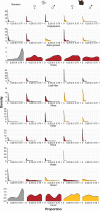Common lizard microhabitat selection varies by sex, parity mode, and colouration
- PMID: 37667183
- PMCID: PMC10478496
- DOI: 10.1186/s12862-023-02158-2
Common lizard microhabitat selection varies by sex, parity mode, and colouration
Abstract
Background: Animals select and interact with their environment in various ways, including to ensure their physiology is at its optimal capacity, access to prey is possible, and predators can be avoided. Often conflicting, the balance of choices made may vary depending on an individual's life-history and condition. The common lizard (Zootoca vivipara) has egg-laying and live-bearing lineages and displays a variety of dorsal patterns and colouration. How colouration and reproductive mode affect habitat selection decisions on the landscape is not known. In this study, we first tested if co-occurring male and female viviparous and oviparous common lizards differ in their microhabitat selection. Second, we tested if the dorsal colouration of an individual lizard matched its basking site choice within the microhabitat where it was encountered, which could be related to camouflage and crypsis.
Results: We found that site use differed from the habitat otherwise available, suggesting lizards actively choose the composition and structure of their microhabitat. Females were found in areas with more wood and less bare ground compared to males; we speculate that this may be for better camouflage and reducing predation risk during pregnancy, when females are less mobile. Microhabitat use also differed by parity mode: viviparous lizards were found in areas with more density of flowering plants, while oviparous lizards were found in areas that were wetter and had more moss. This may relate to differing habitat preferences of viviparous vs. oviparous for clutch lay sites. We found that an individual's dorsal colouration matched that of the substrate of its basking site. This could indicate that individuals may choose their basking site to optimise camouflage within microhabitat. Further, all individuals were found basking in areas close to cover, which we expect could be used to escape predation.
Conclusions: Our study suggests that common lizards may actively choose their microhabitat and basking site, balancing physiological requirements, escape response and camouflage as a tactic for predator avoidance. This varies for parity modes, sexes, and dorsal colourations, suggesting that individual optimisation strategies are influenced by inter-individual variation within populations as well as determined by evolutionary differences associated with life history.
Keywords: Basking; Crypsis; Dorsal colour; Environment; Microhabitat; Oviparous; Pattern; Squamate; Viviparous.
© 2023. BioMed Central Ltd., part of Springer Nature.
Conflict of interest statement
The authors declare that they have no competing interests.
Figures




References
-
- Ahnesjö J, Forsman A. Differential habitat selection by pygmy grasshopper color morphs; interactive effects of temperature and predator avoidance. Evol Ecol. 2006;20:235–57. doi: 10.1007/s10682-006-6178-8. - DOI
-
- Turner JRG. Some early works on heliconiine butterflies and their biology (Lepidoptera, Nymphalidae) J Linn Soc London Zool. 1967;46:255–66. doi: 10.1111/j.1096-3642.1967.tb00507.x. - DOI
Publication types
MeSH terms
LinkOut - more resources
Full Text Sources
